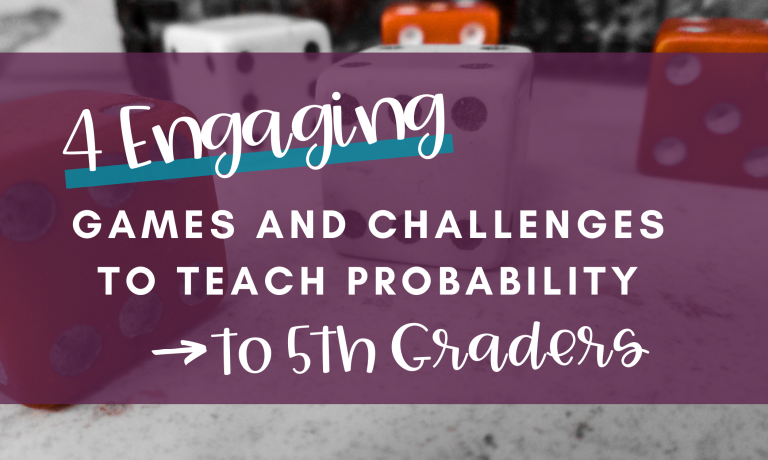Probability is an essential concept in mathematics, and introducing it to students early can help them develop critical thinking and problem-solving skills. However, when you teach probability to 5th graders, it can sometimes be challenging. In this blog post, we’ll explore four exciting games and challenges that can make learning probability a fun and interactive experience for 5th graders.
Game 1: Teach Probability to 5th Graders with Bingo
Bingo is a classic game loved by many, and it can also be a fantastic tool to teach probability. In this game, students are given bingo cards with various probability scenarios. The teacher or facilitator calls out scenarios, such as rolling a dice or drawing a colored ball from a bag, and students mark their cards accordingly. Through this game, students can practice their probability skills and discuss and reflect on the concept.
Game 2: Spinner Experiment to Teach Probability to 5th Graders
Spinners are simple yet effective tools for understanding probability. In this game, students create their spinner with different sections representing possible outcomes. They conduct multiple spins and record the results. By analyzing the collected data, students can calculate the probabilities of each outcome and gain a deeper understanding of how probability works in action.
Materials Needed:
- Cardboard or heavy paper for making spinners (or you can buy spinners here from Amazon)
- A pencil or a paperclip (as a spinner’s arrow)
- Markers or colored pencils for decorating the spinners
- A ruler for dividing the spinner into sections
- Data recording sheets for students to document their spins and outcomes
Instructions:
-
Introduction to Probability and Spinners: Explain to the students what probability is and how it relates to chance. Introduce the concept of a spinner as a tool to demonstrate probability. Show them examples of different spinners and how each section represents a possible outcome.
-
Creating the Spinners: Divide the class into small groups, and provide each group with the necessary materials. Instruct them to create their own spinners by drawing a circle on the cardboard or paper and dividing it into equal sections. Each section should represent a different outcome or event. For example, if you want to teach the concept of probability using colors, they can draw sections for red, blue, green, and yellow.
-
Assigning Probabilities: Have the students assign probabilities to each outcome on their spinner. The probabilities should be represented as fractions, decimals, or percentages. For instance, if there are four sections, each section could have a probability of 1/4, 0.25, or 25%.
-
Spinner Experiment: Once the spinners are ready, it’s time for the students to conduct their experiments. Instruct each group to take turns spinning the arrow and recording the result of each spin. Encourage them to perform several spins (e.g., 20 or 30 spins) to obtain more reliable data.
-
Data Collection and Analysis: After the spinner experiment, gather the students and have them share their data. Guide them in recording the number of times each outcome occurred. This data will allow them to calculate the experimental probabilities for each event.
-
Comparing Experimental and Theoretical Probabilities: Next, discuss the concept of theoretical probability, which is the expected probability based on equal chances of each outcome occurring. Help the students calculate the theoretical probabilities for their spinners. Compare the theoretical and experimental probabilities and discuss any differences or similarities.
-
Drawing Conclusions: Encourage students to conclude their data and analysis. Discuss why the experimental probabilities might differ from the theoretical probabilities and what factors could contribute to these variations. Emphasize that as the number of spins increases, the experimental probabilities should converge toward the theoretical probabilities.
-
Extension Activities: To challenge the students further, you can ask them to create different spinners with varying numbers of sections and different probabilities. This extension will enable them to explore more complex probability concepts and deepen their understanding of chance and randomness.
Game 3: Probability Walk to Teach Probability to 5th Graders
Sometimes, taking the learning experience outside the classroom can make it even more exciting, especially for teaching probability. Setting up a probability walk on the playground or inside the classroom can be a great way to teach probability to 5th graders through experiential learning. In this game, students assign probabilities to different outcomes along the walk, such as finding a feather or spotting a certain type of bird. They take turns going on the walk and record their outcomes. By comparing the results to the predicted probabilities, students can gain insights into the concept of probability and the role of chance.
Game 4: Probability Card Games
Card games are fun and provide ample opportunities to teach probability to 5th graders. Games like War or Go Fish can be modified to include a probability twist. For example, students can assign different probabilities to cards based on their numerical values or colors. Students can better understand probability and its application in real-life scenarios by playing the game and analyzing the outcomes. Teachers can also adapt the game’s complexity to cater to different skill levels, making it suitable for all students.
When you teach probability to 5th graders, it doesn’t have to be dull or intimidating. You can create a stimulating learning environment that fosters curiosity and critical thinking by incorporating engaging games and challenges into the curriculum. The four games and challenges discussed in this blog post, including Probability Bingo, Spinner Experiment, Probability Walk, and Probability Card Games, offer hands-on experiences that make learning probability enjoyable for students. So, why not embrace gamification and experiential learning to spark their interest and set them on a path of mathematical discovery?
